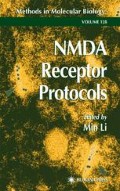Abstract
The quantification of drug interaction with NMDA receptors has been greatly facilitated by the use of ligand binding assays. The first assays for this receptor measured NMDA-sensitive [3H]glutamate binding (see 1 for review). However, [3H]glutamate has relatively low affinity for the receptor, and is also a substrate for transport processes in brain membranes, which can make it difficult to isolate receptor binding from ligand sequestration. The recognition that dissociative anesthetics, such as phencyclidine and ketamine, were NMDA receptor antagonists (2,3) was an important pharmacological advance, because these drugs were more potent NMDA antagonists that others available at the time. However, phencyclidine also proved to be a difficult ligand to use because of nonspecific binding. The identification of MK801 (dizocilpine) and thienylphencyclidine (TCP) as highly potent and very selective inhibitors of NMDA receptor function (4–6) brought the possibility of ligand binding to NMDA receptors into the mainstream.
Access this chapter
Tax calculation will be finalised at checkout
Purchases are for personal use only
References
Foster, A. C. and Fagg, G. E. (1984) Acidic amino acid binding sites in mammalian neuronal membranes: their characteristics and relationship to synaptic receptors. Brain Res. Rev. 7, 103–164.
Anis, N. A., Berry, S. C., Burton, N. R., and Lodge, D. (1983) The dissociative anaesthetics, ketamine and phencyclidine, selectively reduce excitation of central mammalian neurones by N-methyl-aspartate. Br. J. Pharmacol. 79, 565–575.
Honey, C. R., Miljkovic, Z., and MacDonald, J. F. (1985) Ketamine and phencyclidine cause a voltage-dependent block of responses to l-aspartic acid. Neurosci. Lett. 61, 135–139.
Wong, E. H. F., Kemp, J. A., Priestley, T., Knight, A. R., Woodruff, G. N., and Iversen, L. L. (1986) The anticonvulsant MK 801 is a potent N-methyl-d-aspartate antagonist. Proc. Natl. Acad. Sci. USA 83, 7104–7108.
Vignon, J., Chicheportiche, R., Chicheportiche, M., Kamenka, J. M., Geneste, P., and Lazdunski, M. (1983) [3H]TCP: a new tool with high affinity for the PCP receptor in rat brain. Brain Res. 280, 194–197.
Johnson, K. M., Snell, L. D., and Morter, R. S. (1988) N-methyl-d-aspartate enhanced 3H-TCP binding to rat cortical membranes: effects of divalent cations and glycine, in Sigma and Phencyclidine-like Compounds as Molecular Probes in Biology (Domino, E. F. and Kamenka, J. M., eds.). NPP Books, Ann Arbor, pp. 259–268.
Johnson, J. W. and Ascher, P. (1987) Glycine potentiates the NMDA response in cultured mouse brain neurons. Nature 325, 529–531.
Kleckner, N. W. and Dingledine, R. (1988) Requirement for glycine in activation of NMDA receptors expressed in Xenopus oocytes. Science 241, 835–837.
McBain, C. J. and Mayer, M. L. (1994) N-methyl-d-aspartic acid receptor structure and function. Physiol. Rev. 74, 723–760.
Huettner, J. E. and Bean, B. P. (1988) Block of NMDA-activated current by the anticonvulsant MK-801: selective binding to open channels. Proc. Natl. Acad. Sci. USA 85, 1307–1311.
Reynolds, I. J., Murphy, S. N., and Miller, R. J. (1987) 3H-labelled MK-801 binding to the excitatory amino acid receptor complex from rat brain is enhanced by glycine. Proc. Natl. Acad. Sci. USA 84, 7744–7748.
Foster, A. C. and Wong, E. H. F. (1987) The novel anticonvulsant MK801 binds to the activated state of the N-methyl-d-aspartate receptor in rat brain. Br. J. Pharmacol. 91, 403–409.
Bonhaus, D. W. and McNamara, J. O. (1988) N-methyl-d-aspartate receptor regulation of uncompetitive antagonist binding in rat brain membranes: kinetic analysis. Mol. Pharmacol. 34, 250–255.
Starmer, C. F., Packer, D. L., and Grant, A. O. (1987) Ligand binding to transiently accessible sites: mechanisms for varying apparent binding rates. J. Theor. Biol. 124, 335–341.
Kloog, Y., Haring, R., and Sokolovsky, M. (1988) Kinetic characterization of the phencyclidine N-methyl-d-aspartate receptor interaction: evidence for a steric blockade of the channel. Biochemistry 27, 843–848.
Reynolds, I. J. (1990) Arcaine uncovers dual interaction of polyamines with the N-methyl-d-aspartate receptor. J. Pharmacol. Exp. Ther. 255, 1001–1007.
Reynolds, I. J. and Aizenman, E. (1992) Pentamidine is an N-methyl-d-aspartate receptor antagonist and is neuroprotective in vitro. J. Neurosci. 12, 970–975.
Reynolds, I. J. and Miller, R. J. (1988) Multiple sites for the regulation of the N-methyl-d-aspartate receptor. Mol. Pharmacol. 33, 581–584.
Sills, M. A., Fagg, G., Pozza, M., Angst, C., Brundish, D. E., Hurt, S. D., et al. (1991) [3H]CGP 39653: A new N-methyl-d-aspartate antagonist radioligand with low nanomolar affinity in rat brain. Eur. J. Pharmacol. 192, 19–24.
Grimwood, S., Moseley, A. M., Carling, R. W., Leeson, P. D., and Foster, A. C. (1992) Characterization of the binding of [3H]L-689,560, an antagonist for the glycine site on the N-methyl-d-aspartate receptor, to rat brain membranes. Mol. Pharmacol. 41, 923–930.
Reynolds, I. J. and Palmer, A. M. (1991) Regional variations in [3H]MK801 binding to rat brain NMDA receptors. J. Neurochem. 56, 1731–1740.
Rajdev, S. and Reynolds, I. J. (1992) Effects of monovalent and divalent cations on 3-(+)[125I]iododizocilpine binding to the N-methyl-d-aspartate receptor of rat brain membranes. J. Neurochem. 58, 1469–1476.
Rajdev, S. and Reynolds, I. J. (1993) Effects of pH on the actions of dizocilpine at the N-methyl-d-aspartate receptor complex. Br. J. Pharmacol. 109, 107–112.
Laurie, D. J. and Seeburg, P. H. (1994) Ligand affinities at recombinant N-methyl-d-aspartate receptors depend on subunit composition. Eur. J. Pharmacol. Mol. Pharmacol. 268, 335–345.
Lynch, D. R., Anegawa, N. J., Verdoorn, T., and Pritchett, D. B. (1994) N-methyl-d-aspartate receptors: Different subunit requirements for binding of glutamate antagonists, glycine antagonists, and channel-blocking agents. Mol. Pharmacol. 45, 540–545.
Author information
Authors and Affiliations
Editor information
Editors and Affiliations
Rights and permissions
Copyright information
© 1999 Humana Press Inc.
About this protocol
Cite this protocol
Reynolds, I.J., Sharma, T.A. (1999). The Use of Ligand Binding in Assays of NMDA Receptor Function. In: Li, M. (eds) NMDA Receptor Protocols. Methods in Molecular Biology™, vol 128. Humana Press. https://doi.org/10.1385/1-59259-683-5:93
Download citation
DOI: https://doi.org/10.1385/1-59259-683-5:93
Publisher Name: Humana Press
Print ISBN: 978-0-89603-713-7
Online ISBN: 978-1-59259-683-6
eBook Packages: Springer Protocols

